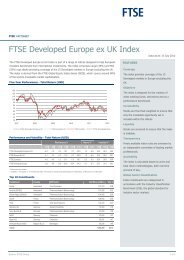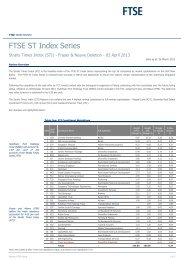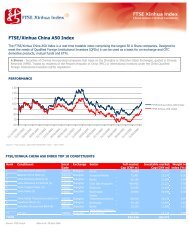Create successful ePaper yourself
Turn your PDF publications into a flip-book with our unique Google optimized e-Paper software.
“bullet bonds”, the natural amortisation of the assets<br />
cannot be relied on to repay the bonds. This means that<br />
funds need to be raised against the assets backing the<br />
covered bond – possibly through the firesale of the assets.<br />
The discount on the price achieved to complete such a<br />
firesale of the assets, in the potentially stressed<br />
environment following the default of the bank that<br />
originated these assets, is referred to as refinancing risk.<br />
Because of the uncertainty surrounding this “refinancing<br />
risk”, Moody’s does not believe that there is a very high<br />
certainty that a“bullet”covered bond would receive full and<br />
timely payment following the default of the bank supporting<br />
the covered bond. This is the primary reason that if the<br />
supporting bank falls below a certain rating level, then a<br />
Moody’s covered bonds rating will usually start migrating.<br />
Moody’s has published the rating levels of the supporting<br />
banks which are expected to constrain the rating level of the<br />
covered bonds.<br />
Some markets do not suffer such material refinancing<br />
risks. For example, in Denmark, the majority of covered<br />
bonds are pass-through bonds, which means that following<br />
the default of a bank supporting a covered bond, the covered<br />
bonds should be able to rely on the natural amortisation of<br />
the assets to pay them back – i.e. the requirement for a<br />
firesale of assets into an illiquid market is much more remote.<br />
Will these challenges be the same across all types of<br />
covered bonds? Or are Jumbo bonds, or bonds with<br />
cross-border pooled assets, for example, different?<br />
NICHOLAS LINDSTROM: Refinancing risks vary deal by<br />
deal and jurisdiction by jurisdiction. The extent to which<br />
refinancing risk is dealt with tends to be different under<br />
different covered bond laws. Further, refinancing risk varies<br />
deal to deal, for example based on the average life of the<br />
assets, and the type and quality of assets included in a cover<br />
pool. Some markets do not suffer such material refinancing<br />
risks. For example, in Denmark, the majority of covered<br />
bonds are pass-through bonds, which means that following<br />
the default of a bank supporting a covered bond, the<br />
covered bonds should be able to rely on the natural<br />
amortisation of the assets to pay them back<br />
If you enjoyed this article, or any other in this<br />
edition of <strong>FTSE</strong> Global Markets and would like<br />
reprints, please contact<br />
Paul Spendiff,<br />
Director,<br />
Berlinguer Ltd<br />
Telephone: 00 44 207 680 5153<br />
Email: paul.spendiff@berlinguer.com<br />
Fax: 00 44 207 680 5155<br />
We will be pleased to help you.<br />
F T S E G L O B A L M A R K E T S • J A N U A R Y / F E B R U A R Y 2 0 0 9<br />
Are there instances of covered bond ratings delinking<br />
from the issuer and other categories of its<br />
debt exposure? Is this feasible going forward?<br />
NICHOLAS LINDSTROM: Currently Moody’s does not<br />
rate any covered bond as delinked. However, if a covered<br />
bond structure was sufficiently sound, a delinked rating<br />
could be assigned. It is easier to envisage a structure<br />
without refinancing risk achieving a“delinked”rating than<br />
a structure that suffers from“refinancing risk”.<br />
How might approaches to ratings change going<br />
forward?<br />
NICHOLAS LINDSTROM: The current extreme climate has<br />
also highlighted the volatility associated with “refinancing<br />
risk”, a risk that the vast majority of covered bonds are<br />
exposed to. In response to this risk Moody’s has updated<br />
some of the refinancing stresses it applies to covered bond<br />
programmes.<br />
Looking forward, given the nature of the product, do<br />
we anticipate an early revival?<br />
TIM SKEET: The key question remains as to when the<br />
covered bond market will revive. A general expectation is<br />
that it will be amongst the first of the asset classes to revive,<br />
although precise timing will depend heavily on the passage<br />
of the government guaranteed bonds and success of the<br />
financial bail outs.The second quarter of 2009 appears to be<br />
the current hope. Investors will also be seeking assurances<br />
on the supply situation as the risk of substantial supply in to<br />
a shrinking investor base was at least one factor that<br />
penalised some parts of the sector previously. Supply will<br />
need to be carefully handled, and market participants will<br />
have to be attentive to the conflicts of interest that will arise<br />
between competing issuers. Contracting bank balance<br />
sheets, de-leveraging and economic slowdown present<br />
macro-economic constraints on supply, but investors will<br />
need to understand how these influences translate into<br />
numbers. Still, regulatory pressure on banks to raise and<br />
maintain liquidity and push out maturities, combined<br />
favourable treatment of the covered bond as an asset for<br />
those additional liquidity reserves, bringing more of this<br />
group of product buyers back to the game, should provide a<br />
solid basis for the return of the asset class.<br />
CARLOS STILIANOPOULOS: We have to go a step at a<br />
time. Currently the appetite is for Government Guaranteed<br />
Bonds, and I am afraid this will last for at least the first six<br />
months of 2009. Probably the next asset class to come back<br />
to the market, in a substantial enough size, will be the<br />
Covered Bond market. However, the question is in what<br />
form will it come back? Will it be mainly in jumbo deals or<br />
small targetted placements? What will hapen with the<br />
market making commitments? There will be too many<br />
questions and it is still too soon to know the answers.<br />
79

















